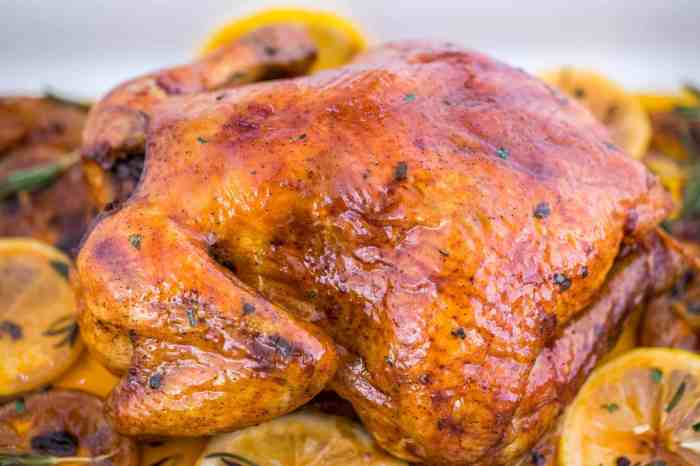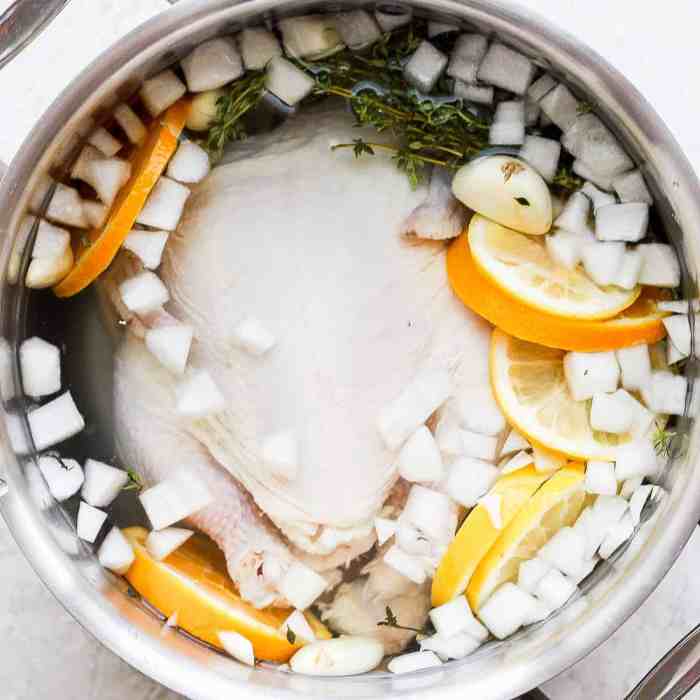Chicken brine recipe is a culinary technique that involves soaking chicken in a salt-based solution, resulting in incredibly juicy and flavorful poultry. This method, practiced for centuries, leverages the science of osmosis to infuse the meat with moisture and enhance its natural flavors.
Brining chicken not only improves its texture and taste but also makes it more forgiving during cooking, reducing the risk of overcooking and dryness. Whether you’re a seasoned chef or a home cook, understanding the fundamentals of chicken brining can elevate your culinary game.
Introduction to Chicken Brining
Chicken brining is a technique that involves soaking raw chicken in a salt-based solution, typically a mixture of water, salt, and sometimes sugar. This process enhances the chicken’s flavor, juiciness, and tenderness. Brining works by drawing moisture into the chicken through a process called osmosis.
Salt, a powerful osmotic agent, draws water molecules from the surrounding brine into the chicken’s cells. This increases the chicken’s overall water content, making it more succulent and less likely to dry out during cooking.
The Science Behind Chicken Brining
Brining leverages the principle of osmosis to improve chicken’s texture and flavor. Osmosis is the movement of water molecules across a semipermeable membrane, from an area of high water concentration to an area of low water concentration.In the context of chicken brining, the chicken’s skin acts as the semipermeable membrane.
When the chicken is submerged in a salt solution, the salt concentration inside the chicken is lower than that of the brine. This difference in concentration drives water molecules from the brine into the chicken’s cells, increasing its moisture content.
The History of Chicken Brining
The practice of brining dates back centuries, with evidence suggesting its use in ancient civilizations. In the early days, brining was primarily used as a method of preserving food, especially meat, before refrigeration was widely available. Salt’s ability to draw moisture out of food and inhibit bacterial growth made it an effective preservative.As refrigeration became more common, brining evolved from a preservation technique to a method of enhancing flavor and texture.
Today, brining is widely used by home cooks and professional chefs alike, as a simple and effective way to improve the quality of chicken dishes.
Types of Chicken Brines
Chicken brines come in various forms, each with its unique characteristics and benefits. Understanding the different types of brines can help you choose the best option for your desired outcome.
Dry Brines
Dry brines are a simple and effective method for enhancing chicken flavor and moisture. They consist of a mixture of salt and sometimes other spices that are rubbed directly onto the chicken. The salt draws out moisture from the chicken, creating a more concentrated flavor and tenderizing the meat.
How Dry Brines Work
The salt in a dry brine draws moisture out of the chicken, creating a more concentrated flavor and tenderizing the meat. This process is known as osmosis. The salt also helps to break down the proteins in the chicken, making it more tender.
Advantages of Dry Brines
- Simple to prepare: Dry brines require no mixing or dissolving, making them incredibly easy to use.
- Flavorful: The salt in a dry brine draws out moisture from the chicken, creating a more concentrated flavor.
- Tenderizing: The salt in a dry brine helps to break down the proteins in the chicken, making it more tender.
- No refrigeration required: Dry brines can be applied directly to the chicken without needing to be refrigerated.
Disadvantages of Dry Brines
- Time-consuming: Dry brines require several hours or even overnight to work effectively.
- Limited moisture retention: Dry brines are not as effective as wet brines at adding moisture to the chicken.
Wet Brines
Wet brines are a mixture of water, salt, and often other ingredients like sugar, herbs, and spices. The chicken is submerged in the brine for a period of time, allowing the flavors and moisture to penetrate the meat.
How Wet Brines Work
Wet brines work by osmosis, where water and salt molecules move from an area of high concentration to an area of low concentration. This process allows the brine to penetrate the chicken, adding moisture and flavor.
Advantages of Wet Brines
- Faster than dry brines: Wet brines work much faster than dry brines, often taking only a few hours.
- Excellent moisture retention: Wet brines are incredibly effective at adding moisture to the chicken, resulting in juicy and tender meat.
- Versatile: Wet brines can be customized with a variety of flavors and ingredients.
Disadvantages of Wet Brines
- Requires refrigeration: Wet brines must be refrigerated to prevent bacterial growth.
- Can dilute the flavor: If the brine is too strong, it can dilute the natural flavor of the chicken.
Flavored Brines
Flavored brines are simply wet brines that have been infused with additional flavors. This can be achieved by adding herbs, spices, citrus fruits, or even vegetables to the brine.
How Flavored Brines Work
Flavored brines work the same way as wet brines, but they also infuse the chicken with additional flavors. The flavors of the herbs, spices, or other ingredients are absorbed into the chicken, creating a more complex and flavorful dish.
Advantages of Flavored Brines
- Versatile: Flavored brines can be customized to suit any taste preference.
- Enhanced flavor: Flavored brines add depth and complexity to the flavor of the chicken.
- Moisture retention: Flavored brines retain moisture just as well as plain wet brines.
Disadvantages of Flavored Brines
- Requires refrigeration: Flavored brines must be refrigerated to prevent bacterial growth.
- Can be messy: Flavored brines can be messy to prepare and clean up.
Comparison Table
| Brine Type | Ingredients | Preparation Time | Benefits |
|---|---|---|---|
| Dry Brine | Salt, spices (optional) | Several hours to overnight | Simple to prepare, flavorful, tenderizing, no refrigeration required |
| Wet Brine | Water, salt, sugar (optional), herbs and spices (optional) | 1-4 hours | Faster than dry brines, excellent moisture retention, versatile |
| Flavored Brine | Wet brine base + herbs, spices, citrus fruits, vegetables (optional) | 1-4 hours | Versatile, enhanced flavor, moisture retention |
Basic Chicken Brine Recipe

A basic chicken brine is a simple and effective way to enhance the flavor and moisture of your chicken. It involves soaking the chicken in a saltwater solution, which helps to retain moisture and improve the overall texture of the meat.
Basic Chicken Brine Recipe
This recipe yields enough brine for a 3-4 pound chicken. Ingredients:* 1 cup kosher salt
- 1 cup granulated sugar
- 1 gallon of cold water
Instructions:
1. Combine the ingredients
In a large container, dissolve the salt and sugar in the cold water.
2. Add the chicken
Submerge the chicken in the brine, ensuring it is fully covered.
3. Refrigerate
Cover the container and refrigerate for at least 4 hours, or up to 24 hours.
4. Remove and rinse
Remove the chicken from the brine and rinse thoroughly with cold water. Pat dry before cooking.
A well-brined chicken will have a juicier and more flavorful texture.
Variations and Flavor Profiles

Brining chicken offers a fantastic opportunity to experiment with different flavors, making your dishes even more delicious and exciting. By adding herbs, spices, citrus, and other ingredients to your brine, you can create unique flavor profiles that complement various chicken recipes.
Flavor Variations
Brining chicken allows for a wide range of flavor possibilities. You can infuse your chicken with bold, savory notes, refreshing citrusy tones, or even subtle hints of sweetness. The choice is yours!
- Herbs:Fresh herbs like thyme, rosemary, sage, parsley, and cilantro add aromatic depth to the chicken. You can use whole sprigs or chop them finely for a more intense flavor.
- Spices:Spices like black peppercorns, garlic powder, onion powder, paprika, cumin, and coriander create complex and savory flavors. Experiment with different spice combinations to find your favorites.
- Citrus:Citrus fruits like lemons, limes, oranges, and grapefruits add a bright and refreshing tang to the chicken. You can use the zest, juice, or even whole slices for a citrusy kick.
- Other Ingredients:Other ingredients like garlic cloves, onions, ginger, chili peppers, and even honey can be added to your brine to enhance the flavor and create unique flavor profiles. For example, adding a few garlic cloves can create a garlicky aroma, while ginger adds a spicy and earthy note.
Flavor Profiles and Ingredients, Chicken brine recipe
Here’s a table outlining some common flavor profiles and the ingredients you can use to achieve them:
| Flavor Profile | Ingredients |
|---|---|
| Herby | Thyme, rosemary, sage, parsley, cilantro |
| Spicy | Black peppercorns, cayenne pepper, chili flakes, garlic powder, ginger |
| Citrusy | Lemon zest, lime juice, orange peel, grapefruit segments |
| Savory | Garlic cloves, onion powder, black peppercorns, bay leaves |
| Sweet and Savory | Honey, brown sugar, garlic cloves, onion powder |
Brining Techniques and Tips
Brining is a simple but effective technique that involves soaking chicken in a salt-based solution to enhance its flavor and moisture. The salt draws out moisture from the chicken, creating a more tender and flavorful product. This section will discuss the proper methods for brining chicken, including the optimal time, temperature, and container selection.
It will also provide tips for optimizing the brining process for different chicken cuts and recipes, and demonstrate the proper technique for removing excess brine from the chicken before cooking.
Brining Time and Temperature
The time required for brining chicken depends on the size and cut of the chicken. Smaller cuts, such as chicken breasts, can be brined for as little as 30 minutes, while larger cuts, such as whole chickens, may require up to 12 hours.
The ideal temperature for brining is between 34-40 degrees Fahrenheit (1-4 degrees Celsius). At this temperature, the salt will effectively penetrate the chicken without promoting bacterial growth.
It’s important to note that brining at room temperature is not recommended due to the risk of bacterial contamination.
Container Selection
The container you choose for brining should be large enough to hold the chicken comfortably, with enough space for the brine to circulate freely. A non-reactive container, such as a stainless steel bowl or a food-grade plastic container, is ideal.
Avoid using containers made of aluminum, as they can react with the brine and affect the flavor of the chicken.
Optimizing the Brining Process for Different Chicken Cuts and Recipes
For smaller cuts of chicken, such as breasts or thighs, a shorter brining time is sufficient. Larger cuts, such as whole chickens or legs, may require a longer brining time to allow the salt to penetrate fully. The type of recipe you are making will also influence the brining time.
For example, if you are roasting a chicken, a longer brining time will help to ensure that the meat is evenly cooked and juicy.
If you are grilling chicken, a shorter brining time is generally preferred.
Removing Excess Brine
After brining, it is important to remove excess brine from the chicken before cooking. This can be done by patting the chicken dry with paper towels or by rinsing it under cold water.
It is important to remove excess brine to prevent the chicken from becoming too salty.
Discover the crucial elements that make tips hamil anak laki laki the top choice.
Cooking Brined Chicken: Chicken Brine Recipe

Brining chicken infuses it with moisture and enhances its flavor, resulting in a juicy and flavorful final product. Cooking brined chicken requires some adjustments to traditional cooking methods to ensure optimal results.
Cooking Methods for Brined Chicken
Brined chicken can be cooked using various methods, each influencing the cooking time and temperature.
- Roasting: Roasting is a popular method for cooking whole chickens or individual pieces. Brined chicken cooks faster than unbrined chicken due to the increased moisture content. The internal temperature should reach 165°F (74°C) for safe consumption.
- Grilling: Grilling is an excellent way to achieve a crispy exterior and juicy interior. Brined chicken cooks faster on the grill, so adjust the cooking time accordingly. The internal temperature should reach 165°F (74°C).
- Frying: Frying, whether pan-frying or deep-frying, results in a crispy, golden-brown exterior. Brined chicken cooks faster in oil, so adjust the cooking time accordingly. The internal temperature should reach 165°F (74°C).
- Baking: Baking is a convenient method for cooking chicken. Brined chicken cooks faster in the oven, so adjust the baking time accordingly. The internal temperature should reach 165°F (74°C).
Cooking Time and Temperature Adjustments
Brining affects the cooking time and temperature for each method.
- Roasting: The cooking time for brined chicken is typically reduced by 15-20% compared to unbrined chicken. The internal temperature should reach 165°F (74°C).
- Grilling: Brined chicken cooks faster on the grill, so reduce the cooking time by 15-20%. The internal temperature should reach 165°F (74°C).
- Frying: Brined chicken cooks faster in oil, so reduce the frying time by 15-20%. The internal temperature should reach 165°F (74°C).
- Baking: Brined chicken cooks faster in the oven, so reduce the baking time by 15-20%. The internal temperature should reach 165°F (74°C).
Tips for Cooking Brined Chicken
- Pat Dry: Before cooking, pat the chicken dry with paper towels to remove excess moisture. This helps achieve a crispy exterior.
- Avoid Overcrowding: When roasting or baking, ensure the chicken pieces are not overcrowded in the pan. This allows for even cooking and prevents steaming.
- Use a Meat Thermometer: Always use a meat thermometer to ensure the chicken reaches an internal temperature of 165°F (74°C).
- Rest: After cooking, allow the chicken to rest for 10-15 minutes before carving. This allows the juices to redistribute, resulting in a more flavorful and tender chicken.
Benefits of Brining Chicken
Brining chicken is a simple yet effective technique that can significantly elevate your cooking game. By immersing the chicken in a saltwater solution, you unlock a world of juicy, flavorful, and tender results that will leave you wondering why you didn’t do it sooner.
Increased Moisture and Juiciness
Brining chicken infuses it with moisture, resulting in a remarkably juicy and tender final product. This is achieved through the process of osmosis. When the chicken is submerged in the brine, the salt draws water from the solution into the chicken’s muscle fibers.
This process helps to plump up the chicken and retain moisture during cooking. The result is a chicken that is incredibly tender and moist, even when cooked to the recommended internal temperature.
Enhanced Flavor
Brining doesn’t just make chicken juicier; it also enhances its natural flavor. The salt in the brine acts as a flavor enhancer, amplifying the chicken’s inherent taste. Additionally, you can customize the brine with herbs, spices, and other flavorings to further enhance the chicken’s profile.
This allows you to create a symphony of flavors that perfectly complements your dish.
Improved Tenderness
Brining also helps to break down the proteins in the chicken, leading to increased tenderness. The salt in the brine helps to tenderize the meat, resulting in a more delicate and enjoyable eating experience. This is particularly noticeable in tougher cuts of chicken, such as the breast, which can benefit significantly from the tenderizing effect of brining.
Consistent Cooking Results
Brining contributes to more consistent cooking results. The added moisture from brining helps to prevent the chicken from drying out during cooking, ensuring that it cooks evenly and thoroughly. This is especially helpful for larger pieces of chicken, such as whole chickens or large breasts, which can be prone to uneven cooking.
Enhanced Flavor Profile
Brining opens up a world of flavor possibilities. You can customize your brine with various herbs, spices, and flavorings to create a unique flavor profile for your chicken. For example, a simple lemon-herb brine can add a bright and refreshing taste, while a garlic-ginger brine can impart a savory and aromatic depth.
The possibilities are endless, allowing you to experiment and find your perfect flavor combination.
Final Conclusion
With the right brine recipe and technique, you can unlock the full potential of your chicken, creating dishes that are both delicious and impressive. Whether you’re seeking a simple, basic brine or experimenting with flavorful variations, the possibilities are endless.
So, grab your ingredients, follow our guide, and prepare to experience the transformative power of brining.
